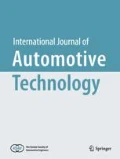Abstract
This paper describes a parallel model-based fault detection algorithm for an electronic parking brake (EPB) system, which consists of an electronic control unit with built-in current sensor and braking force sensor. For the EPB system to supply sufficient parking force to a vehicle, the parking force sensor is of utmost importance. If a fault occurs in this sensor, sufficient parking force may not be supplied, thereby seriously threatening the safety of the vehicle. Thus, a fault detection method is required for the parking force sensor of the EPB system to improve the safety of vehicles. For this purpose, a highly reliable fault detection method is needed to detect abnormal fault signals, which cannot be detected by the existing on-line sensor monitoring fault detection methods. This paper proposes a novel parallel model-based fault detection algorithm for the EPB system, which compares the physical sensor data with the mathematical model, the fuzzy model, and the neural network model at the same time. In order to reduce false alarms, the magnitude of thresholds and the operation counts are changed adaptively. When the proposed parallel model-based fault detection algorithm detects severe failures of the force sensor, it warns the driver in advance to prevent accidents due to the failures. The proposed algorithm is verified by hardware-in-theloop simulations in various situations.
Similar content being viewed by others
References
Albas, E., Arikan, T. and Kuzkaya, J. C. (2001). In-process motor testing results using model-based fault detection approach. Proc. Elect. Insulation Conf. and Elect. Manufacturing and Coil Winding Conf., 643–647.
Altinten, A., Erdgan, S., Hapglu, H. and Alpbaz, M. (2003). Control of a polymerization reactor by fuzzy control method with genetic algorithm. Comput. Chem. Eng., 27, 1031–1040.
Beard, R. V. (1971). Failure accommodation in linear systems through self-organization. Technical Report MVT-7 I-1, Man Vehicle Lab, MIT, Cambridge.
Bose, N. and Raghavan, I. (2005). Prediction of emissions using combustion parameters in a diesel engine fitted with ceramic foam diesel particulate filter through artificial neural network techniques. Int. J. Automotive Technology 6,2, 95–105.
Boskovic, J. and Mehra, R. K. (1998). A multiple modelbased reconfigurable flight control system design. Proc. 37th IEEE Conf. Decision and Control, Tampa, FL, 4503–4508.
Choi, C. S., Tae, S. J., Kim, H. M., Cho, K. N., Moon, J. M., Kim, J. Y. and Kwon, H. J. (2005). Fuzzy algorithm for FDD technique development of system multi-air conditioner. Trans. KSME B 29,11, 1220–1228.
Chung, H., Chun, J., Kwon, S. and Kim, K. (2008). Development and performance evaluation of single puller type electric parking brake (EPB). KSAE 2008 Annual Conf., 2202–2206.
Demuth, H., Beale, M. and Hagan, M. (2009). Neural Network Toolbox™ 6 User’s Guide. MathWorks.
Fennel, H. and Ding, E. L. (2000). A model-based failsafe system for the continental TEVES electronic-stabilityprogram (ESP). SAE Automotive Dynamics & Stability Conf., SAE Paper No. 2000-01-1635.
Fussel, D., Balle, P. and Isermman, R. (1997). Closed loop fault diagnosis based on a nonlinear process model and automatic fuzzy rule generation. IFAC Symp. Safeprocess ′97, 1, 359–364.
Gopinathan, M., Boskovic, J. D. and Mehra, R. K. (1998). A multiple model predictive scheme for fault-tolerant flight control design. Proc. 37th IEEE Conf. Decision and Control, Tampa, Florida.
Han, K., Huh, K., Hong, D., Kim, J., Kang, H. and Yoon, P. (2008). Real-time model-based fault diagnosis system for EHB system. Trans. KSAE 16,4, 173–178.
Iida, O., Sato, M., Kiguchi, M., Iwamura, T. and Fukumura, S. (1988). Blast Furnace Control by Artificial Intelligence. Artificial Intelligence in Real-time Control. Rodd, M. G. and Suski, G. J. edn. Swansea. Pergamon Press. UK. 73.
Isermann, R. and Balle, P. (1997). Trends in the application of model-based fault detection and diagnosis of technical process. Control Eng. Practice 5,5, 709–719.
Jung, H. G., Lee, Y. H., Kim, B. J., Yoon, P. J. and Kim, J. (2007). Stereo vision-based forward obstacle detection. Int. J. Automotive Technology 8,4, 493–504.
Maybeck, P. S. and Stenvens, R. D. (1991). Reconfigurable flight control via multiple model adaptive control methods. IEEE Trans. Aerospace and Electron. Syst. 27,3, 470–479.
Mihov, G., Dimitrov, E. and Nenov, N. (2004). Temperature errors compensation of force sensor for railway carriages wheel load measuring. 27th Int. Spring Seminar, 486–490.
Moon, B. and Park, C. (2009). Robust model based fault detection of EPB system for varying temperature. Trans. KSAE 17,5, 26–30.
Moon, B.-J., Kim, D.-H. and Park, C.-K. (2009). Fuzzy model-based fault detection method of EPB system for varying temperature. J. Control, Autom. and Syst. Eng. 15,10, 1009–1013.
Patton, R. J. and Chen, J. (1994). Fault diagnosis in nonlinear dynamic systems via neural networks. Proc. IEE Int. Conf. Control, 2, 1346–1351.
Patton, R. J. and Willcox, S. W. (1987). Parameter insensitive technique for aircraft sensor. fault analysis. J. Guidance, Control, and Dynamics 10,3, 359–367.
Peng, Y.-Q. and Li, W. (2009). Research on fuzzy control strategies for automotive EPB system with AMESim/simulink co-simulation. 2009 Chinese Control and Decision Conf. (CCDC 2009), 1707–1712.
Pfeufer (1997). Application of model based fault detection and diagnosis to the quality assurance of an automotive actuator. Control Eng. Practice 5,5, 703–708.
Sorsa, T. (1991). Neural networks in process fault diagnosis. IEEE Trans. Syst. Man and Cybern. 21,4, 815–825.
Sorsa, T. and Koivo, H. (1993). Dynamic fault diagnosis using radial bas is function networks. TOOLDIAG ′93, Toulouse, 160–169.
Sreedhar, R., Fernandez, B. and Masada, G. Y. (1995). A neural network based adaptive fault detection scheme. Proc. IEEE Amer. Control Conf., Seattle, Washington, 3259–3263.
Author information
Authors and Affiliations
Corresponding author
Rights and permissions
About this article
Cite this article
Moon, B.J., Jung, H.G., Lee, S.G. et al. Parallel model based fault detection algorithm for electronic parking brake system. Int.J Automot. Technol. 15, 483–494 (2014). https://doi.org/10.1007/s12239-014-0051-5
Received:
Revised:
Accepted:
Published:
Issue Date:
DOI: https://doi.org/10.1007/s12239-014-0051-5



